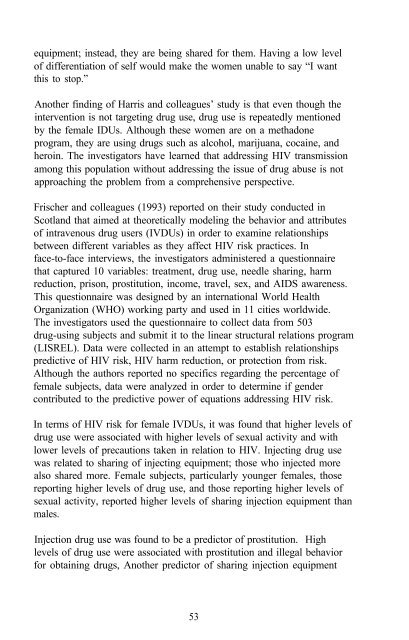The Context of HIV Risk Among Drug Users and Their Sexual Partners
The Context of HIV Risk Among Drug Users and Their Sexual Partners
The Context of HIV Risk Among Drug Users and Their Sexual Partners
You also want an ePaper? Increase the reach of your titles
YUMPU automatically turns print PDFs into web optimized ePapers that Google loves.
equipment; instead, they are being shared for them. Having a low level<br />
<strong>of</strong> differentiation <strong>of</strong> self would make the women unable to say “I want<br />
this to stop.”<br />
Another finding <strong>of</strong> Harris <strong>and</strong> colleagues’ study is that even though the<br />
intervention is not targeting drug use, drug use is repeatedly mentioned<br />
by the female IDUs. Although these women are on a methadone<br />
program, they are using drugs such as alcohol, marijuana, cocaine, <strong>and</strong><br />
heroin. <strong>The</strong> investigators have learned that addressing <strong>HIV</strong> transmission<br />
among this population without addressing the issue <strong>of</strong> drug abuse is not<br />
approaching the problem from a comprehensive perspective.<br />
Frischer <strong>and</strong> colleagues (1993) reported on their study conducted in<br />
Scotl<strong>and</strong> that aimed at theoretically modeling the behavior <strong>and</strong> attributes<br />
<strong>of</strong> intravenous drug users (IVDUs) in order to examine relationships<br />
between different variables as they affect <strong>HIV</strong> risk practices. In<br />
face-to-face interviews, the investigators administered a questionnaire<br />
that captured 10 variables: treatment, drug use, needle sharing, harm<br />
reduction, prison, prostitution, income, travel, sex, <strong>and</strong> AIDS awareness.<br />
This questionnaire was designed by an international World Health<br />
Organization (WHO) working party <strong>and</strong> used in 11 cities worldwide.<br />
<strong>The</strong> investigators used the questionnaire to collect data from 503<br />
drug-using subjects <strong>and</strong> submit it to the linear structural relations program<br />
(LISREL). Data were collected in an attempt to establish relationships<br />
predictive <strong>of</strong> <strong>HIV</strong> risk, <strong>HIV</strong> harm reduction, or protection from risk.<br />
Although the authors reported no specifics regarding the percentage <strong>of</strong><br />
female subjects, data were analyzed in order to determine if gender<br />
contributed to the predictive power <strong>of</strong> equations addressing <strong>HIV</strong> risk.<br />
In terms <strong>of</strong> <strong>HIV</strong> risk for female IVDUs, it was found that higher levels <strong>of</strong><br />
drug use were associated with higher levels <strong>of</strong> sexual activity <strong>and</strong> with<br />
lower levels <strong>of</strong> precautions taken in relation to <strong>HIV</strong>. Injecting drug use<br />
was related to sharing <strong>of</strong> injecting equipment; those who injected more<br />
also shared more. Female subjects, particularly younger females, those<br />
reporting higher levels <strong>of</strong> drug use, <strong>and</strong> those reporting higher levels <strong>of</strong><br />
sexual activity, reported higher levels <strong>of</strong> sharing injection equipment than<br />
males.<br />
Injection drug use was found to be a predictor <strong>of</strong> prostitution. High<br />
levels <strong>of</strong> drug use were associated with prostitution <strong>and</strong> illegal behavior<br />
for obtaining drugs, Another predictor <strong>of</strong> sharing injection equipment<br />
53
















